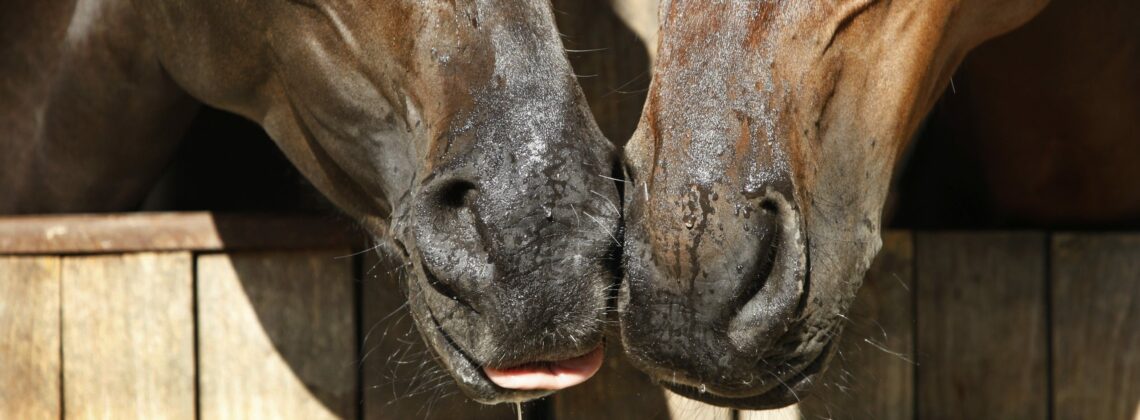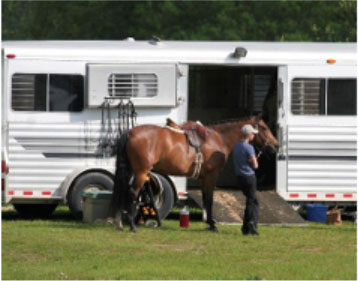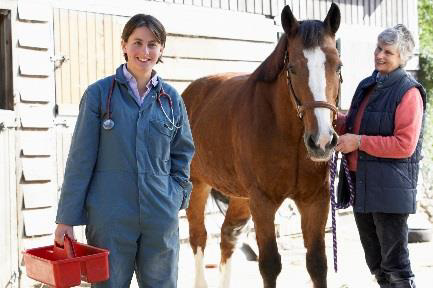Health & Education
We all want the best care possible for our horses. The Heath & Education section covers both Learning Institutions, Organizations as well as many sources for equine assistance including Veterinarians and Farriers.
For those who want a to formally study horses, the Education section includes College Riding, Equine Studies, and Veterinary Schools. Learn about the wide variety of horses in the Horse Breeds section. Supplements and Treatments Therapy are also included in the section.
Everyone can learn from Fine Art and there are some specialty Museums that might surprise you.
Horses as a therapy partner enrich the lives of the disabled. These facilities are listed in our Therapeutic Riding section. To help children and young adults build confidence and grow emotionally, please see the resources available on the Youth Outreach page.
Looking for a place to keep your horse? You can find it in the Horse Boarding section. Traveling? Find a Shipping company or Horse Sitting service if your horse is staying home!
Want to stay up to date with the latest training clinics or professional conferences? Take a look at our Calendar of Events for Health & Education for the dates and locations of upcoming events.
Do we need to add more? Please use the useful feedback link and let us know!

by Alicia Skelding, Equine Guelph
Introduction
The term Biosecurity refers to management practices that reduce the chance infectious disease will be carried onto a farm by animals or people and the spread of infectious disease on farms. All infectious diseases of horses result from the interactions between the animal and its ability to resist disease (immunity), an infectious agent (bacteria, viruses, and parasites) and the environment. These relationships allow opportunities for preventing or reducing infectious diseases.
Horses

New Arrivals
The most common way infectious diseases are spread is when a new horse arrives at a property that is a carrier of the disease. A veterinary examination is recommended prior to purchasing a horse. Depending on where the horse has originated from, the veterinarian may advise for specific tests to be conducted to rule out infectious diseases.
New horses should be isolated from resident horses for thirty days. The horse should be checked daily for signs of illness, including monitoring the horse’s temperature, food and water intake. Separate stable/yard equipment, buckets, grooming supplies, tack etc should be used for new horses and marked with red tape. The new horse should be handled last, morning and night, and hands should be washed upon leaving the horse’s stall or paddock.
Vaccination
Vaccination can be a critical aspect of controlling infectious diseases because in many instances owners cannot prevent exposure. It is important to remember that vaccination cannot prevent disease. Vaccines perform best if the disease challenge is minimized. In some instances, vaccination does not provide protection against infection but merely decreases the severity of clinical disease. Vaccination serves to increase resistance against certain diseases in individual horses as well as horse populations.
A vaccination program is most effective when it is planned to meet the particular needs of a farm. Setting up a strategic vaccination program means:
- determining what diseases to vaccinate against
- identify who will most benefit from vaccination, and
- finding out when they will most need the protection that vaccines provide.
Your veterinarian will provide guidelines for a vaccination program that suits your needs.
Quarantine
Quarantine, in which a horse is completely separated from contact with other horses, is a smart strategy for limiting the transmission of disease. It’s a good idea when you have a sick horse to separate him from his apparently healthy barn mates. When you have a new arrival they should be quarantined from resident horses.
When setting up a quarantine facility whether it is one stall or many, consider how you will best limit the spread of infection.
- Limit the amount of shared airspace between quarantined horses and the general population – ideally by placing the isolation stalls in a separate building.
- Limit movement of insects, by screening doors and windows and using insecticidal sprays.
- Equip the quarantine facility with separate feeding, mucking and grooming equipment.
- If possible, your quarantine barn should be downwind of your main barn.
Quarantine is not strictly for sick or new horses, horses that have left the farm for showing or breeding purposes also have the potential to bring home germs. These horses should be isolated for at least two weeks, making sure there is no noseto-nose contact.
Humans
Personnel
Assign specific individual(s) to care for affected horses. Ideally a caretaker should not be responsible for both healthy and exposed/affected horses. If unavoidable, care of healthy animals should be completed first; exposed animals next; affected animals last. Disposable gloves, plastic booties and barrier clothing should be used when working with sick horses.
After handling sick horses, gloves and booties should be disposed of in a sealed trash container and clothing placed in a covered hamper. Hands must be washed under running water with liquid soap for a minimum of 15 seconds.
Visitors
Ideally there should be only one entrance / exit into your farm, marked as the main entrance. Parking should be away from horses to help keep disease-carrying organisms from being tracked from car floors or tires to your horses. If the farrier or veterinarian needs to park closer, be sure their tires and shoes have been disinfected. Ask all visitors to wear clean clothes and shoes. Give visitors plastic shoe covers, or brush dirt off their shoes and spray with disinfectant. If you have many visitors, such as a farm tour or open house make a footbath for them to walk through.
Records of visitors to your farm with date, time, name and purpose of visit should be kept. On larger properties, record details of horse(s) the visitor came in contact with.
Away From Farm
Coming into contact with a diseased horse at an event/activity is another way in which horses can be infected with a disease. When attending events take your own equipment (buckets, tack, grooming supplies), do not share your equipment or use communal water troughs. Monitor your horse’s health while at the event. Avoid tying/yarding your horse with other horses thereby minimizing direct contact and always wash your hands if you have touched other peoples horses. Good records of horse movement should be kept as well as disinfecting equipment, tack and transport vehicles after returning from the event.
Management Practices
Manure and Bedding
Waste management procedures are not limited to organisms shed in feces but are applicable to all infectious agents. Manure on wheelbarrow tires, tractor tires etc is a potential source of the infectious agent and can be tracked everywhere on the grounds if tires are not properly cleaned and disinfected. Do not put waste material from the stalls of affected horses onto open-air manure piles/pits. Do not spread manure from affected horses onto pastures.
Equipment/Supplies
Horse-specific equipment (fed-tubs, water buckets, halters etc) should be clearly identified as belonging to an individual horse and be used only by that horse. Shared equipment (lead shanks, lip chains, bits, twitches, thermometers etc) should be cleaned of organic debris and disinfected between horses.
All equipment should be thoroughly scrubbed and cleaned with detergent and water, rinsed, disinfected and followed by a final rinse. This should be done in an area with minimal foot and traffic flow that can be cleaned and disinfected after this procedure. Cloth items (saddle pads, towels, bandages) should be laundered and thoroughly dried between each use (disinfectant may be added to rinse water). Equipment that cannot be effectively disinfected (sponges, brushes) should not be shared between horses. Multiple dose medications should be labeled for use by a specific horse and not shared.
Disinfecting
The number one rule for disease control is cleaning. This means the removal of all manure and feed, followed by washing, scrubbing, rinsing or pressure washing, all surfaces with hot water and detergent. This is followed by the use of a disinfectant.
There are three steps in order for this process to be effective. Step one: remove loose material. Surfaces must first be cleaned in order for disinfectants to be effective. Ensure all manure and dirt is brushed off the surface. Step two: wash. Wash the item or surface with warm soapy water and rinse thoroughly and dry. Step three: disinfect. Once the item or surface is dry, disinfectant can be applied.
Tack items and footwear can be wiped with a disinfectant wipe or can be sprayed with disinfectant and wiped over with a clean dry cloth. Horse transport vehicles and floors of stables can be sprayed with disinfectant made up in a spray bottle or large surface sprayer.
When choosing a disinfectant, it is also important to refer to the specific product claim including the spectrum of activity. It is important to read the labels carefully and to follow the directions including accurately calculating the dilutions and respecting the recommended contact time.
Environment
Vermin control is critical, as pests can transmit a number of diseases. Rodent, bird and insect control should be evaluated and upgraded as necessary. Screens should be installed in stall windows. A control program may include the use of traps, repellants and/or insecticides/rodenticides. Non-equines (goats, cats, dogs) should not be permitted within the primary perimeter.
Conclusions
Every horse owner needs to do everything they can to reduce the risk of an infectious disease from being introduced to their property and horses. Taking basic precautions is common sense and once you are in the habit, they are quite easy to implement. Reducing the incidence of infectious disease in our animals, saves time, money and enhances the quality of life for both horse and owner. Prevention is always easier than cleanup.
Equine Guelph is the horse owner and caregiver’s Centre at the University of Guelph, supported and overseen by equine industry groups, dedicated to improving the health and well-being of horses.
This article originally appeared on Equine Guelph The University of Ontario, Canada, and is published here with permission.
DOWNLOAD a PDF of this information.
You can find more informative articles in our section on Health & Education.

Isolate Sick, New & Travelling Horses Checklist
Your isolation plan involves both physical structures and your management practises.

Equine Guelph would like to extend thanks to Dr. Josie Traub-Dargatz and Dr. Alanna Kirby, Colorado State University for input and content review of this infosheet.
To learn more about equine biosecurity, register for Equine Guelph’s online course and visit the biosecurity risk calculator online tool. Isolate Sick, New & Travelling Horses
This article originally appeared on Equine Guelph The University of Ontario, Canada, and is published here with permission.
You can DOWNLOAD a PDF of this checklist.
You can find more informative articles in our section on Health & Education.
- Do You Ride Big or Small? and excerpt from "Ride Big" by John Haime
- Rood & Riddle "Stallside" Podcast - The Science and Benefits of Equine Plasma with Sarah Myer Thompson (38:11)
- Olfactory Stimulation Enriches Horses’ Environments
- Whole Food Options to Boost Protein Quality
- Monty Roberts Gentling Your Spooky Horse (4:17)
- The Biomechanics of Engagement :The Essential Components of Self Carriage (18:19)
- Monty Roberts: A Real Horse Whisperer (49:43)
- Julie Goodnight: Don't wear a bike helmet for horseback riding (0:30)
- Julie Goodnight: Quick Tip to Stay out of Horse's Kick Zone, CHA (0:29)
- The Uniqueness of Icelandic horses, Part 2 (7:15)
- Beyond Dust Reduction: Soaking Hay Improves Lung Function in Asthmatic Horses
- Air Quality and Air Pollution’s Impact on Your Horse’s Lungs
- Restricting Forage is Incredibly Stressful - Choose a different approach for weight loss
- Reading the Horse's Vital Signs with Teddy Franke (1:43)
- The Uniqueness of Icelandic horses - Part 1 (8:02)
- Blanketing the Horse Safely with Tammi Gainer (8:35)
- Riding Exercises to Improve Rider Position with Christy Landwehr from Certified Horsemanship Association (9:50)
- Why Wear a Helmet? Riders Share Harrowing Close Calls
- Monty Robert's 88th Birthday - Cutting (43:03)
- Good Riding Position with Ken Najorka (8:06)

































